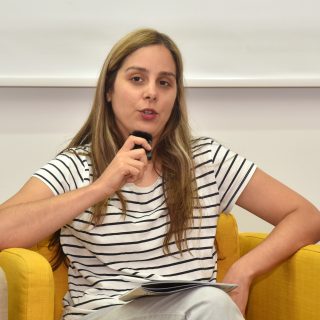Remembering the Role of Women During the War in Bosnia and Herzegovina
If relied exclusively on the programs and messages of commemorations, street names, names of institutions, and what has been written on memorial plaques and monuments in post-war Bosnia and Herzegovina, it would be hard to believe that there had been any women at all who have participated in war and peace building activities. On the other hand, the oral and unofficial culture of memory points us to the immense contribution of women in all aspects of life during the war. Analyzing this still alternative counterbalance to the official narratives, one can wonder how could we have ever survived the war without women? Where and why is the female perspective of the war marginalized? Why are the women of Bosnia and Herzegovina not part of the culture of remembrance in the public space? Why are they not a mandatory part of the process of official memorialization?
In order to come to an answer, one must first examine who creates the official narratives, who uses them, and how. In the context of the war in Bosnia and Herzegovina, the most active creators of the official culture of remembrance are ethno-national parties and the media sympathetic to them; the religious and academic communities; the competent ministries for veteran issues and associations, as well as the victims’ families. The ministries are usually the formal organizers of commemorations of significant war dates.
The commemorations of war anniversaries have had almost identical programs since 1996. It seems to be a given that they must include these elements: visiting cemeteries (preferably areas designated for fallen soldiers), placing flowers on monuments to fallen soldiers (which, as a rule, preserve the memory of fallen male defenders), religious rituals (an opportunity to connect war, faith, identity, and tradition), formal events (opportunities for political and academic positioning), history classes in schools (with information that is not part of the official curriculum) and the announcement of a competition for children’s literary and artistic works on the topic of war (children write about and paint commanders and battles inspired by the emotions and memories of their parents.)
If (!) there is room for her at all, part of the program positions the woman in the role of the victim based on the patriarchal matrix of national policies: the mother or wife of a fallen fighter, a victim of rape and other war crimes, or a powerless part of the population whose survival depended on men. Never as a subject, but exclusively as an object.
Aware of the central role of the ministry[1] for veteran issues in the culture of remembrance of the past war, and of the fact that there is no relevant state ministry, it is important to note that of six persons who have held the position of a minister at the level of the entity of the Federation of Bosnia and Herzegovina, only one was a woman. On the other hand, the entity of Republic Srpska did not have a woman at the head of the relevant ministry. Without insinuating that women ministers would lead a different policy of memory culture, in the context of this article, it is indicative that women are often not even an option for the first positions in ministries[2] for veteran issues.
Questioning participation in the war is often used as an effective discrediting tool among men, especially in political life. The man is acceptable, legitimate, and politically untouchable in proportion to the perception that allies, opponents, and the general public have about his role in the war and in the reconstruction of the country after the war. On the other hand, the same principle is absolutely ignored in the case of women. The socio-political activity of women is almost never[3] brought into connection with their wartime past in the public sphere. Moreover, this past is either ignored or belittled. There are numerous examples of testimonies about the reduction of military ranks, the unjust demobilization of women after the war, and not awarding medals to deserving women members of military units[4].These are examples that depict the military dimension of the war, but especially the attitude towards women was similar in other social spheres as well.
The competent public officials ignore civil society initiatives that aim to include the women perspective and their contribution in the official memory culture. Since 2014, the women’s activist movement “Peace with Women’s Face” Initiative has been trying to get the support of the Parliamentary Assembly of Bosnia and Herzegovina to declare December 8 as the Official Day of Remembrance for women killed in the war in Bosnia and Herzegovina.[5] Despite being ignored by institutions that have given no feedback, the associations gathered in this activist network informally to commemorate this date every year on the streets of 12 cities in Bosnia and Herzegovina.[6]
Another example of how women’s contribution and its inclusion in the official culture of memory is being neglected is the attempt to name the square opposite the Sarajevo City Hall. The CURE Foundation, on behalf of the “Peace with Women’s Face” Initiative, and with the support of several civil society organizations, took the initiative that this square be named after Aida Buturović, the librarian of the National and University Library of Bosnia and Herzegovina, who was killed on her way home from the operation to save books from the burning City Hall.[7] Competent institutions decided on the established practice of giving priority to military or police units for street names, i.e. their male members, and named it The First Police Brigade Square. After facing criticism from the civil society, the mayor of Sarajevo announced the installation of a memorial plaque in memory of Aida Buturović.[8] Placing this memorial plaque on the sidelines, rather than on a visible and significant public space, is another missed opportunity to name public spaces after deserving women, and a reminder of the problematic practice of naming streets and institutions in Bosnia and Herzegovina.
The 2022 Guide to Naming Streets After Women[9] exposes devastating statistics. The streets named after women or after women’s activism and experience make up only 1.48% in Sarajevo, 0.5% in Mostar, 6.61% in Banja Luka, and 2.45% in Tuzla. The group of activists behind the above-mentioned Guide also prepared the lexicon[10] “100 women – 100 streets named after women” with biographies of women who pushed the boundaries in their communities in Bosnia and Herzegovina. This and other publications[11] with the same and similar topics provide information about deserving women in Bosnia and Herzegovina, with the aim of contributing to the literature on women and exerting pressure to give women their deserved place in the culture of memory.
Taking into account all of the above, the question arises as to how and with whom to continue the struggle for women’s place in the official culture of memory. A fragmented political system, a lack of political will, and a strong synergy of actors who rule the current culture of memory lead to a wall which, according to the current rules of the game, is difficult to jump over. The “new players” – the generations born after the war in Bosnia and Herzegovina – carry the biggest potential for changing those rules. Although they are often written off as the internet generation, uninterested in the recent past, these globally oriented young people who are not consumers of conventional means of information, may be the last part of society not poisoned by hatred. At the moment, a large part of them is not involved in the issue of memory culture, but their numbers are growing every day. And the day will come when they will start looking for information about their grannies and their role in the war of the nineties. It is up to today’s fighters for gender equality and fairer positioning of women in the culture of memory to provide them with as many arguments and resources as possible to achieve those goals.
Edo Kanlić is a peace activist from Goražde who currently lives and works in Sarajevo. He studied at the universities of Ankara, Prague, Bologna, and Sarajevo in an undergraduate study program in international relations and a master’s study program in the field of human rights and democracy in Southeast Europe. He currently works at the Sarajevo Open Center as a coordinator of the Initiative for Monitoring the European Integration of Bosnia and Herzegovina. In his activist work, he dealt with the topics of education, segregation in schools, active participation of young people in decision-making processes, dealing with the past and memorialization. He is a lover of literature, theater art and music, and currently sings in the Sarajevo Mixed Chamber Choir “Lola”.
[1] The mandate of Minister Suada Hadžović lasted less than two years, from March 12, 2001 to February 14, 2003.
[2] The situation is similar with cantonal ministries. The Sarajevo Canton had a total of 12 ministers and not a single woman in that position. Currently, no cantonal departmental ministry is headed by a woman, and the websites of most cantonal governments do not offer information about previous convocations.
[3] However, there were also examples like this: the current state parliamentarian Sabina Ćudić’s political opponents challenged her candidacy for mayor of Sarajevo, saying that she had lived in Belgrade during the war. Although it is irrelevant information where the candidates for public positions lived in different periods of their lives, it is interesting to note that the candidate Ćudić was 10 years old at the beginning of the war. More at:
[4] Elvira Aganović, “Women at War”, recorded in May 2010 in the production of Radio-Television of the Bosnian-Podrinje Canton of Goražde, video format, 57:00; 1:00:00, https://www.youtube.com/watch?v=Ne73aWRwJFw&t=23s
Sunita Dautbegović-Bošnjaković, “The Forgotten Dimension of the War in Bosnia and Herzegovina – Female Soldiers”, in What is the Gender of Safety, ed. Damir Arsenijević and Tobias Flessenkamper (Sarajevo, Sarajevo Open Center, 2013) 79-98, available at: https://soc.ba/site/wp-content/uploads/2013/02/Kojeg-je-roda-sigurnost_WEB_bos.pdf
Mirjana Trifković, “The other side of the coin”, Dealing with the Past, last updated on July 8, 2020,https://dwp-balkan.org/bs/druga-strana-medalje/
[5] Azem Kurtić, “Marked memory of women killed in war”, Detektor.ba, last updated on December 8, 2022, https://detektor.ba/2022/12/08/obiljezeno-sjecanje-na-zene-ubijene-u-ratu/
[6] Edina Rizvić, “December 8 – Day of Remembrance for the Victims of Women in the War in Bosnia and Herzegovina”, RTV Slon, last updated on December 7, 2022, https://www.rtvslon.ba/8-decembar-dan-sjecanja-na-stradanje-zena-u-ratu-u-bosni-i-hercegovini/
[7] “Trg near Vijećnica to be named after Aida Buturović: She tried to save books from the burning building, she was killed on the way home”, DEPO, last updated on December 17, 2021, https://depo.ba/clanak/225296/trg-kod-vijecnice-nazvati-po-aidi-buturovic-iz-zapaljene-zgrade-pokusavala-spasiti-knjige-ubijena-na-putu-do-kuce
[8] “Sarajevo raises a memorial plaque to Aida Buturović, the heroine who saved books from the burning City Hall,” Klix.ba, last updated on August 25, 2022, https://www.klix.ba/vijesti/bih/sarajevo-podize-spomen-plocu-aidi-buturovic-heroini-koja-je-spasavala-knjige-iz-zapaljene-vijecnice/220825113
[9] Jasmina Čaušević, Lejla Gačanica and Ljilja Lukić, Guide to naming streets after women (Bijeljina-Sarajevo: Foundation “Lara” Bijeljina and Forum Ziviler Friedensdienst e.V., 2022), available at: http://hcabl.org/wp-content/uploads/2022/03/Vodic-za-imenovanje-ulica-po-zenama-WEB.pdf
[10] ed. Gorica Ivić, Jasmina Čaušević and Selma Hadžihalilović, Lexicon about women who pushed the boundaries in their communities in Bosnia and Herzegovina: 100 women – 100 streets named after women (Sarajevo, Bijeljina, Tuzla: Forum Ziviler Friedensdienst e.V., Fondacija “Lara” Bijeljina, Association HO HORIZONTI Tuzla, 2021), available at: https://dwp-balkan.org/wp-content/uploads/2022/05/100-zena-100-ulica-po-zenama-WEB22_compressed_1651813903.pdf
[11] Examples in literature are: Women of Bosnia and Herzegovina, They Are Ours Today, Recorded – Women and the Public Life of Bosnia and Herzegovina in the 20th century.




